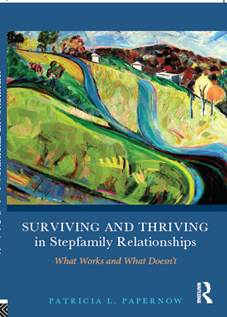[:en]

Editor’s Note: An earlier version of this article first appeared on The Family Dinner Project in 2013. It has since been updated by the author.
Some of the most intense challenges for stepfamilies unfold at the family dinner table.
In a stepfamily, the deepest bonds are typically those between the parent and his or her children, not between the stepparent and stepchildren, nor between the stepcouple. Parent-child relationships share so much history. This history includes unspoken agreements about everything from whether Grape Nuts is a form of cardboard or a breakfast food, to the appropriate use of cell phones at meals. This makes a stepparent, late to the party, a “stuck outsider.” The child(ren)’s parent is a “stuck insider.” When the parent turns to his or her kid(s) the stepparent is left out. Turning to the stepparent leaves kids out. Stuck outsiders often feel invisible and rejected. Stuck insiders often feel torn and anxious.
Dinner time also reminds children of how dramatically their family has changed. The new couple relationship is a wonderful gift to the adults. However, study after study tells us that when parents recouple, children lose a significant amount of parental attention. They also have to deal with yet another in a series of unwelcome changes.
The dinner table is a prime place where all of these dynamics get played out.
For instance, Mom’s or Dad’s new partner is now here during dinner, a time when kids really want the focus on them. Children naturally come to the table needing to reach out to their own parent for connection and caring, not to the interloper who is stealing their parent’s attention. They naturally want to share their stories with their parent, not with their stepparent. Stepparents can find themselves sitting through entire meals with no eye contact from either their stepchildren or from their partners, who are absorbed in responding to their kids. And, if the stepparent speaks up later, parents often feel torn and get defensive, leaving both feeling more alone.
The good news is that there are steps you can take to make things better:
- Parents and stepparents can work together to make meal times more pleasurable, or at least more bearable. The parent needs to be the “shuttle diplomat.” While listening to children, parents can take care of stepparents by playing footsie under the table with their partners (out of children’s eyesight), and by remembering to regularly turn away from kids to provide some eye contact with the stepparent. After children have been well heard, parents can also change the subject to something that includes the stepparent.
- Two Truths and a Tall Tale is a wonderful way to make room for all these different stepfamily pulls. Each person tells three brief stories, two true and one not true. The others have to guess which is which. In stepfamilies, so much unshared history is woven into the fabric of pre-stepfamily life. The storytelling game is a fun way to have stepfamily members to tell stories shared by some and not others and to learn a bit more about each other.
- Another, simpler dinner table idea is to ask each person to share “a rose and a thorn” – one good thing and one not-so-good thing that happened to them that day. Both of these strategies provide a structure for each person at the table to speak and to be heard, without competition. And they both provide some easy, fun ways for people in step relationships to get to know each other.
- One of the best ways to create a healthy stepfamily is quite non-intuitive—spend regular time in one-to-one relationships. Stepfamilies do need to do fun things together. AND carving out regular reliable time for parent-child, couple, and stepparent-stepchild relationships meets core needs for connection without competition. Children need time when they have their parent’s full attention. Stepcouples need time without Mom or Dad being pulled into the parent-child relationship. Stepparent and stepchild need time to get to know each other away from the stronger parent-child relationship.
- Parent and child may set aside one evening for a Mom (or Dad) and child dinner. Dad or Mom may drive a child to school each day or spend special time together just before bed. Stepcouple may set aside extra time to snuggle in the morning or evening (out of children’s eye shot). Stepparent and stepchild may shoot baskets together, make Dad’s birthday cake or play a game together. The various pairs in the family (adult stepcouple, two stepsibs, stepparent and stepchild, parent and child) may take turns making a dessert.
In addition to these concrete “things to do,” creativity and a sense of humor also help. When my husband and I first got together, my 13-year-old daughter was a staunch vegetarian. Her only protein was tofu. My husband was a pure red meat eater. To him tofu was not a food and vegetables were an anathema. I loved vegetables and my preferred protein was chicken or fish. One evening we figured out that we could begin our meals by sautéing a huge pan of the three items we all liked: Mushrooms, garlic, and onions. We’d then remove a third for my husband, who would add his red meat. My daughter and I would add a pile of veggies to the remaining two thirds. I either ate tofu with my daughter, or split the pan again and added fish or chicken for my portion. Tadah! Problem solved.
It is important to know that some things do change over time. In about year three or four, my daughter began eating fish and, soon after that, added chicken. She went to college in Iowa and learned to eat red meat. In year five, a stint in Weight Watchers inspired my husband to eat chicken (much lower point values). By year ten we could easily sit down to a shared meal of grilled chicken and brown rice. In year 27, the vegetable bin, however, remains entirely Papernow territory.
Becoming a stepfamily is a process, not an event. It takes time and patience—lots of it. It’s a lot less like blending a fruit smoothie and more like thoughtfully putting together a fruit salad. Even over time, some flavors and shapes remain quite distinct and yet the salad forms a satisfying whole.
Dr. Papernow is entering her fifth decade of working with, learning about, and teaching others about stepfamily relationships. She is widely recognized as one of our foremost experts on “blended families” and has received many awards for her work. Patricia is the author of numerous articles and book chapters and is often interviewed by national and local media. Her book, Surviving and Thriving in Stepfamily Relationships: What Works and What Doesn’t, written for both stepfamily members and helping professionals, is recognized as a classic in the field. Most recently she co-authored The Stepfamily Handbook: From Dating to Getting Serious to Forming a “Blended Family” with Karen Bonnell.
To learn more about Dr. Papernow and about stepfamilies, visit her website.
[:es]
 Some of the most intense challenges for stepfamilies unfold at the family dinner table.
Some of the most intense challenges for stepfamilies unfold at the family dinner table.
In a stepfamily, the deepest bonds are typically those between the parent and his or her children, not between the stepparent and stepchildren. The parent-child relationship shares so much history, not to mention unspoken agreements about everything from whether Grape Nuts is a form of cardboard or a breakfast food, to the appropriate use of cell phones at meals. The dinner table is a prime place where these rules and customs get played out. The stepparent, late to the party, may feel like a “stuck outsider.” The child’s parent is a “stuck insider,” closest to the stepparent, to his or her kids, and, for better or for worse, to their ex-spouse.
Dinner is also a time when children are reminded of how dramatically their family has changed. The new couple relationship is a long-awaited, wonderful gift to the adults. For kids, however, it often means a loss of parental attention and yet another in a series of difficult changes.
For instance, mom’s new partner is now here during dinner, a time when kids really want her to focus on them. Children naturally come to the table needing to reach out to their own parent for connection and caring, not to the interloper who is stealing her attention. They naturally want to share their stories with their parent, not with their new stepparent. Unfortunately, stepparents can find themselves sitting through entire meals without receiving any eye contact from their stepchildren or from their partners, who are absorbed in responding to their kids.
The good news is that there are steps you can take to make things better:
- Parents and stepparents can work together to make meal times more pleasurable, or at least more bearable. The parent needs to be the “shuttle diplomat.” While listening to children, parents can take care of stepparents by playing footsie under the table with their partners (out of children’s eyesight), and by remembering to turn away from kids to provide some eye contact with the stepparent. After children have been well heard, parents can change the subject to something that includes the stepparent.
- An activity on this web site called Two Truths and a Tall Tale, sounds quite wonderful to me: Each person tells three brief stories, two true and one not true. The others have to guess which is which. In stepfamilies, family history is shared between parents and their children, not within step relationships. Many stories are so much a part of the fabric of family life that it would not occur to anybody to tell them. The storytelling game is a way to have fun while learning a bit more about each other. Another, simpler idea is to ask each person to share one good thing and one not-so-good thing that happened to them that day. Both of these strategies provide a structure for each person at the table to speak and be heard. They both help people in step relationships get to know each other.
- One of the best ways to create a healthy stepfamily is quite non-intuitive—spend lots of time in one-to-one relationships. Building relationships one dyad at a time is easier than expecting a stepparent to blend right in to a preexisting family. Parent and child may set aside one evening for a mom (or dad) and child dinner. The various pairs in the family (adult stepcouple, two stepsibs, stepparent and stepchild, parent and child) may take turns making a dessert. The adult stepcouple can set a “date night” every week or two.
- Creativity and a sense of humor also help. When my husband and I first got together, my 13-year-old daughter was a staunch vegetarian. Her only protein was tofu. My husband was a red meat eater. To him tofu was not a food and vegetables were an anathema. I loved vegetables and my preferred protein was chicken or fish. We figured out that we could begin our meals by sautéing a huge pan of the three items we all liked: mushrooms, garlic, and onions. We’d then remove a third for my husband, who would add his red meat. My daughter and I would add a pile of veggies to the remaining two thirds. I either ate tofu with my daughter, or split the pan again and added fish or chicken for my portion.
- It is important to know that some things do change over time. In about year three or four, my daughter began eating fish and, soon after that, added chicken. She went to college in Iowa and learned to eat red meat. In year five, a stint in Weight Watchers inspired my husband to eat chicken (much lower point values). Now, in year 17, we can all easily sit down to a shared meal of grilled chicken and brown rice. The vegetable bin, however, remains entirely mine.
 Becoming a stepfamily is a process, not an event. It takes time and patience—lots of it. Think of it this way: It’s less like blending a fruit smoothie and more like thoughtfully putting together a fruit salad. Even over time, some flavors and shapes remain quite distinct and yet the salad forms a satisfying whole.
Becoming a stepfamily is a process, not an event. It takes time and patience—lots of it. Think of it this way: It’s less like blending a fruit smoothie and more like thoughtfully putting together a fruit salad. Even over time, some flavors and shapes remain quite distinct and yet the salad forms a satisfying whole.
Dr. Papernow is in private practice in Hudson, MA, where she divides her time between clinical practice, supervision, and training. She is in her fourth decade of working with, learning about, and teaching others about stepfamily relationships. Patricia is widely recognized as one of our foremost experts on “blended families” and post-divorce parenting. She is the author of numerous articles and book chapters and is often interviewed by national and local media. Her first book, Becoming a Stepfamily, is widely recognized as a classic in the field. Her second book, Surviving and Thriving in Stepfamily Relationships: What Works and What Doesn’t was recently published to rave reviews.
To learn more about Dr. Papernow, visit her website.
[:]


Leave a Reply
You must be logged in to post a comment.